Osaka Castle
| Osaka Castle 大坂城 | |
|---|---|
|
Osaka Castle viewed from Nishinomaru Garden | |
| Type | Azuchi-Momoyama castle |
| Site information | |
| Condition | Reconstructed |
| Site history | |
| Built | 1583 |
| Built by | Toyotomi Hideyoshi |
| In use | 1583–1868 |
| Demolished | 1868 |

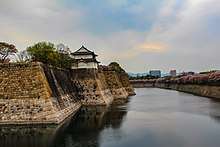
Osaka Castle (大坂城 or 大阪城, Ōsaka-jō) is a Japanese castle in Chūō-ku, Osaka, Japan. The castle is one of Japan's most famous landmarks and it played a major role in the unification of Japan during the sixteenth century of the Azuchi-Momoyama period.[1]
Description
The main tower of Osaka Castle is situated on a plot of land roughly one square kilometer. It is built on two raised platforms of landfill supported by sheer walls of cut rock, using a technique called Burdock piling, each overlooking a moat. The central castle building is five stories on the outside and eight stories on the inside, and built atop a tall stone foundation to protect its occupants from attackers.
The castle grounds, which cover approximately 60,000 square meters (15 acres),[2] contain thirteen structures that have been designated as important cultural assets by the Japanese government,[3] including:
- Ote-mon Gate
- Sakura-mon Gate
- Ichiban-yagura Turret
- Inui-yagura Turret
- Rokuban-yagura Turret
- Sengan Turret
- Tamon Turret
- Kinmeisui Well
- Kinzo Storehouse
- Enshogura Gunpowder Magazine
- Three sections of castle wall all located around Otemon Gate
History

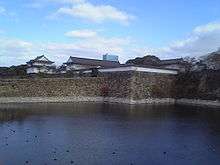
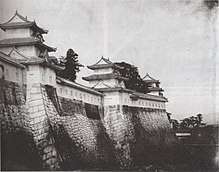

In 1583 Toyotomi Hideyoshi commenced construction on the site of the Ikkō-ikki temple of Ishiyama Hongan-ji.[4] The basic plan was modeled after Azuchi Castle, the headquarters of Oda Nobunaga. Toyotomi wanted to build a castle that mirrored Oda's, but surpassed it in every way: the plan featured a five-story main tower, with three extra stories underground, and gold leaf on the sides of the tower to impress visitors. In 1585 the Inner donjon was completed. Toyotomi continued to extend and expand the castle, making it more and more formidable to attackers. In 1597 construction was completed and Hideyoshi died the year after. Osaka Castle passed to his son, Toyotomi Hideyori.
In 1600 Tokugawa Ieyasu defeated his opponents at the Battle of Sekigahara, and started his own bakufu (i.e., shogunate) in Edo. In 1614 Tokugawa attacked Toyotomi in the winter, starting the Siege of Osaka.[5] Although the Toyotomi forces were outnumbered approximately two to one, they managed to fight off Tokugawa's 200,000-man army and protect the castle's outer walls. Ieyasu had the castle's outer moat filled, negating one of the castle's main outer defenses.
During the summer of 1615, Hideyori began to restore the outer moat. Tokugawa, in outrage, sent his armies to Osaka Castle again, and routed the Toyotomi men inside the outer walls on June 4.
Osaka Castle fell to the Tokugawa clan, the Toyotomi clan perished, and the castle buildings burned to the ground.[4]:153
In 1620, the new heir to the shogunate, Tokugawa Hidetada, began to reconstruct and re-arm Osaka Castle. He built a new elevated main tower, five stories on the outside and eight stories on the inside, and assigned the task of constructing new walls to individual samurai clans. The walls built in the 1620s still stand today, and are made out of interlocked granite boulders without mortar. Many of the stones were brought from rock quarries near the Seto Inland Sea, and bear inscribed crests of the various families who contributed them.
Construction of the 5 story tenshu started in 1628 and was completed 2 years later, about the same time the rest of the reconstruction, and followed the general layout of the original Toyotomi structure.[4]:153-157
In 1660, lightning ignited the gunpowder warehouse and the resulting explosion set the castle on fire.
In 1665, lightning struck and burnt down the tenshu.[4]:157 In 1843, after decades of neglect, the castle got much-needed repairs when the bakufu collected money from the people of the region to rebuild several of the turrets.
In 1868, Osaka Castle fell and was surrendered to anti-bakufu imperial loyalists. Much of the castle was burned in the civil conflicts surrounding the Meiji Restoration.[4]:157
Under the Meiji government, Osaka Castle became part of the Osaka Army Arsenal (Osaka Hohei Kosho) manufacturing guns, ammunition, and explosives for Japan's rapidly expanding Western-style military.[6]
In 1931, the ferroconcrete tenshu was built.[4]:157
During World War II, the arsenal became one of the largest military armories, employing 60,000 workers.[6] Bombing raids targeting the arsenal damaged the reconstructed main castle tower and, on August 14, 1945, destroyed 90% of the arsenal and killed 382 people working there.
In 1995, Osaka's government approved yet another restoration project, with the intent of restoring the main tower to its Edo-era splendor. In 1997, restoration was completed. The castle is a concrete reproduction (including elevators) of the original and the interior is intended as a modern, functioning museum.
Views of the castle
- Osaka Castle at night
- Osaka Castle pedestrian entrance
 Central tower
Central tower Otemon (western) Gate
Otemon (western) Gate Early representation of the destruction of the 1663 François Caron book
Early representation of the destruction of the 1663 François Caron book.jpg) From the roof of Osaka Castle Main Tower
From the roof of Osaka Castle Main Tower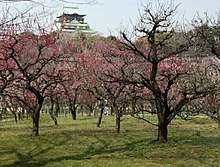 Prunus mume Grove in Osaka Castle Park
Prunus mume Grove in Osaka Castle Park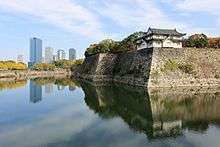 Outer Moat and Osaka Business Park
Outer Moat and Osaka Business Park
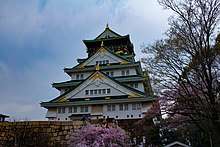
Accessibility
The castle is open to the public and is easily accessible from Osakajōkōen Station on the JR West Osaka Loop Line. It is a popular spot during festival seasons, and especially during the cherry blossom bloom (hanami), when the sprawling castle grounds are covered with food vendors and taiko drummers. The large indoor arena, Osaka-jō Hall, also is located within the grounds of the castle park.
In popular culture
The castle was featured in The Amazing Race 20. The castle also appears in the 1955 Toho tokusatsu film Godzilla Raids Again, in which it is destroyed after Godzilla pins Anguirus against the castle, causing it to collapse. In 1975, British novelist James Clavell used the castle and its environs (circa 1600) as a major plot location for his most famous work of historical fiction, Shogun.
See also
References
- ↑ "Uemachidaichi : OSAKA-INFO – Osaka Visitor's Guide". Osaka-info.jp. Archived from the original on December 28, 2012. Retrieved 2013-02-15.
- ↑ "Osaka / Osaka Castle". Japanese National Tourist Organization. Retrieved 2008-01-22.
- ↑ "Osaka Castle". GoJapanGo. Retrieved 2010-10-08.
- 1 2 3 4 5 6 Hinago, Motoo (1986). Japanese Castles. Kodansha International Ltd. and Shibundo. p. 153. ISBN 0870117661.
- ↑ Meek, Miki. "The Siege of Osaka Castle". National Geographic Magazine. Retrieved 2008-01-22.
- 1 2 "Osaka Army Arsenal". Ndl.go.jp. Archived from the original on 2013-02-09. Retrieved 2013-02-15.
Literature
- Mitchelhill, Jennifer (2013). Castles of the Samurai:Power & Beauty. USA: Kodansha. ISBN 978-1568365121.
- Schmorleitz, Morton S. (1974). Castles in Japan. Tokyo: Charles E. Tuttle Co. pp. 69–78. ISBN 0-8048-1102-4.
- Motoo, Hinago (1986). Japanese Castles. Tokyo: Kodansha. pp. 200 pages. ISBN 0-87011-766-1.
External links
| Wikivoyage has a travel guide for Osaka. |

- Official website

- Japanese Castle Explorer – Osaka Castle
Coordinates: 34°41′14″N 135°31′33″E / 34.68722°N 135.52583°E